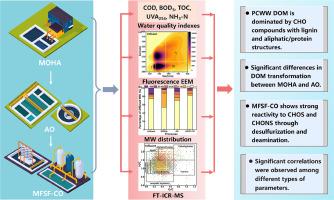当前位置:
X-MOL 学术
›
Water Res.
›
论文详情
Our official English website, www.x-mol.net, welcomes your feedback! (Note: you will need to create a separate account there.)
Molecular-level insights into dissolved organic matter and its variations of the full-scale processes in a typical petrochemical wastewater treatment plant
Water Research ( IF 11.4 ) Pub Date : 2024-06-25 , DOI: 10.1016/j.watres.2024.121990 Min Li , Zhouyang Li , Liya Fu , Liyan Deng , Changyong Wu
Water Research ( IF 11.4 ) Pub Date : 2024-06-25 , DOI: 10.1016/j.watres.2024.121990 Min Li , Zhouyang Li , Liya Fu , Liyan Deng , Changyong Wu

|
Petrochemical wastewater (PCWW) treatment poses challenges due to its unique and complex dissolved organic matter (DOM) composition, originating from various industrial processes. Despite the addition of advanced treatment units in PCWW treatment plants to meet discharge standards, the mechanisms of molecular-level sights into DOM reactivity of the upgraded full-scale processes including multiple biological treatments and advanced treatment remain unclear. Herein, we employ water quality indexes, spectra, molecular weight (MW) distribution, and Fourier transform ion cyclotron resonance mass spectrometry to systematically characterize DOM in a typical PCWW treatment plant including influent, micro-oxygen hydrolysis acidification (MOHA), anaerobic/oxic (AO), and micro-flocculation sand filtration–catalytic ozonation (MFSF–CO). Influent DOM is dominated by tryptophan-like and soluble microbial products with MW fractions 〈 1 kDa and 〉 100 kDa, and CHO with lignin and aliphatic/protein structures. MOHA effectively degrades macromolecular CHO (10.86 %) and CHON (5.24 %) compounds via deamination and nitrogen reduction, while AO removes CHOS compounds with MW < 10 kDa by desulfurization, revealing distinct DOM conversion mechanisms. MFSF–CO transforms unsaturated components to less aromatic and more saturated DOM through oxygen addition reactions and shows high CHOS and CHONS reactivity via desulfurization and deamination reactions, respectively. Moreover, the correlation among multiple parameters suggests UV combined with AI as a simple monitoring indicator of DOM to access the chemical composition. The study provides molecular-level insights into DOM for the contribution to the improvement and optimization of the upgraded processes in PCWW.
中文翻译:

对典型石化废水处理厂中溶解有机物及其全过程变化的分子水平洞察
石化废水 (PCWW) 的处理因其独特而复杂的溶解有机物 (DOM) 成分(源自各种工业过程)而面临挑战。尽管PCWW处理厂增加了深度处理单元以满足排放标准,但从分子水平观察包括多重生物处理和深度处理在内的升级全流程DOM反应性的机制仍不清楚。在此,我们采用水质指标、光谱、分子量(MW)分布和傅里叶变换离子回旋共振质谱来系统地表征典型PCWW处理厂中的DOM,包括进水、微氧水解酸化(MOHA)、厌氧/好氧(AO)和微絮凝砂滤-催化臭氧化(MFSF-CO)。流入的 DOM 主要是分子量分数 < 1 kDa 和 > 100 kDa 的类色氨酸和可溶性微生物产物,以及具有木质素和脂肪族/蛋白质结构的 CHO。 MOHA 通过脱氨和氮还原有效降解大分子 CHO (10.86 %) 和 CHON (5.24 %) 化合物,而 AO 通过脱硫去除分子量 < 10 kDa 的 CHOS 化合物,揭示了不同的 DOM 转化机制。 MFSF-CO通过氧加成反应将不饱和组分转化为芳香族较少和饱和度较高的DOM,并分别通过脱硫和脱氨反应表现出高CHOS和CHONS反应活性。此外,多个参数之间的相关性表明,UV 与 AI 相结合可以作为 DOM 的简单监测指标来获取化学成分。该研究提供了对 DOM 的分子水平见解,有助于 PCWW 升级流程的改进和优化。
更新日期:2024-06-25
中文翻译:

对典型石化废水处理厂中溶解有机物及其全过程变化的分子水平洞察
石化废水 (PCWW) 的处理因其独特而复杂的溶解有机物 (DOM) 成分(源自各种工业过程)而面临挑战。尽管PCWW处理厂增加了深度处理单元以满足排放标准,但从分子水平观察包括多重生物处理和深度处理在内的升级全流程DOM反应性的机制仍不清楚。在此,我们采用水质指标、光谱、分子量(MW)分布和傅里叶变换离子回旋共振质谱来系统地表征典型PCWW处理厂中的DOM,包括进水、微氧水解酸化(MOHA)、厌氧/好氧(AO)和微絮凝砂滤-催化臭氧化(MFSF-CO)。流入的 DOM 主要是分子量分数 < 1 kDa 和 > 100 kDa 的类色氨酸和可溶性微生物产物,以及具有木质素和脂肪族/蛋白质结构的 CHO。 MOHA 通过脱氨和氮还原有效降解大分子 CHO (10.86 %) 和 CHON (5.24 %) 化合物,而 AO 通过脱硫去除分子量 < 10 kDa 的 CHOS 化合物,揭示了不同的 DOM 转化机制。 MFSF-CO通过氧加成反应将不饱和组分转化为芳香族较少和饱和度较高的DOM,并分别通过脱硫和脱氨反应表现出高CHOS和CHONS反应活性。此外,多个参数之间的相关性表明,UV 与 AI 相结合可以作为 DOM 的简单监测指标来获取化学成分。该研究提供了对 DOM 的分子水平见解,有助于 PCWW 升级流程的改进和优化。






































 京公网安备 11010802027423号
京公网安备 11010802027423号